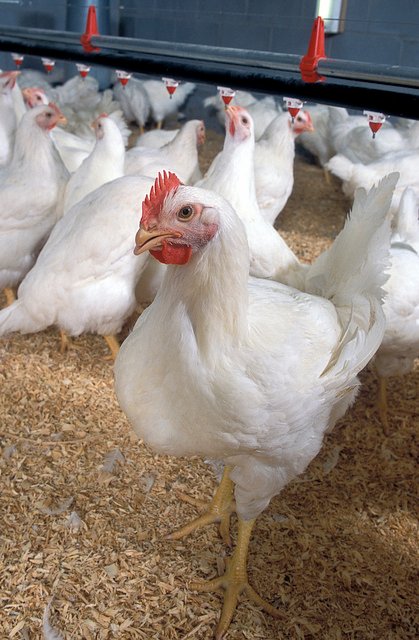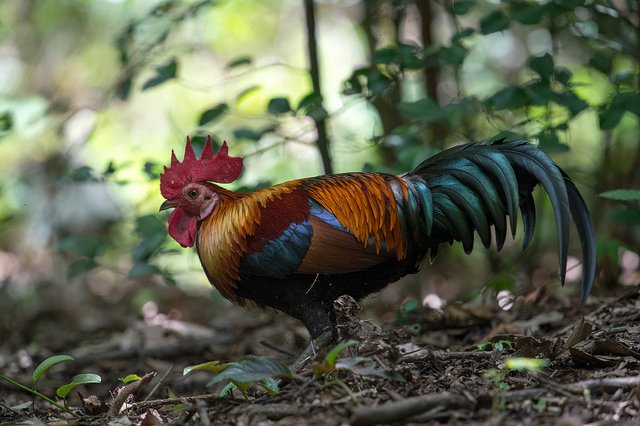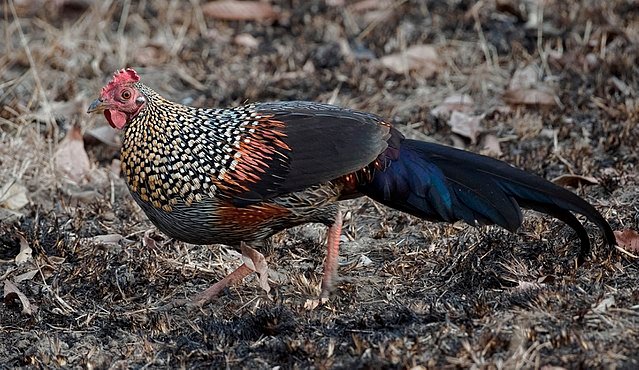I have always been amazed by the collective gall of humans as a species. Even as a kid, whenever we would drive through a mountainous area, I would notice the vertical grooves on the rock walls left by the drills that were used to carve the roadway straight through the middle of the mountain. Think about that for a second: people decided they wanted a road there, so they blew the side of a mountain off to make it happen.
Another example of mankind's audacity can be seen in the chicken. Modern domesticated chickens (Gallus gallus domesticus) come in a seemingly infinite number of varieties, each bred for different uses and characteristics. Some were selectively bred for meat production. Not only do these chickens grow to be very large, but they get there very quickly and with a minimum input of food.

Image Credit:Poultry Classes Blog photo by US Department of Agriculture
The Cornish cross has become the industry standard for growing meat chickens. They are a cross between a male Cornish chicken and a female white Plymouth Rock. Over time, the Cornish cross has been selectively bred to be ultra-efficient when it comes to converting food into body mass, achieving an average feed conversion ratio of 1.83 in the US in 2017 with even lower averages reported in New Zealand. In other words, for every 1.83 pounds of feed that an industrially raised Cornish cross eats, it will gain 1 pound of body weight. That is insane! For some perspective, in 1925 (in the US), the average broiler took an average of 112 days to make it to market weight. Even then, they weighed an average of 2.5 lbs (live weight) with an average feed conversion ratio of a whopping 4.7. Compare that to today’s bird that matures in about 47 days and weighs in at an average of 6.27 lbs, and you’ll begin to see just how much we’ve changed our domesticated chickens in a relatively short amount of time. But, this is not a new phenomenon. Humans have been selectively breeding these birds for thousands of years.
The History Of The Chicken
Archeological evidence indicates that humans first began keeping chickens as domestic animals as early as 7000 BC. It all started in India and East Asia where different cultures independently began catching and taming the native wild ancestors of our modern chickens. Like our modern versions, those ancient progenitors were not great at flying, which made them easy targets. But, how did we get from these wild jungle birds to the massive 6+ lb Cornish crosses or the sex-linked hens that can lay in excess of 300 eggs in a year (up from about 150 in 1947, by the way). It’s a long, convoluted, and sometimes controversial story.From Not So Humble Beginnings
For the longest time, it was thought that the modern domesticated chicken had only one ancestor, Gallus gallus, the red junglefowl.Red Junglefowl - Male

Image Credit: Red Junglefowl by Jason Thompson
Red Junglefowl - Female
.jpg)
Image Credit: Red Junglefowl (Gallus gallus) - second female by Lip Kee
As the name implies, the red junglefowl inhabits the jungles of India and Asia. The species exhibits sexual dimorphism, which means that males look different than females. The male bird is generally larger and more colorful than the female, possessing rusty red plumage accented by dark, iridescent feathers on the chest and tail. He will also have a red colored comb and sharp talons, much like the domestic chickens that we are familiar with, today. Females, on the other hand, are smaller and lack the comb and sharp talons. Furthermore, since they are the lone caretakers of their young, they have adapted a more drab color scheme that better blends in with their surroundings.
Interestingly, these birds probably weren’t first domesticated to serve as a food source, but more likely for use in religious rituals. Researchers think that the domestication process happened (and continues to happen) in steps. It starts off with humans and chickens living side-by-side; coexisting within the same habitat. Over time, the bombastic birds came to be important religious icons. The people began to capture them for use in religious and political rituals, including cockfighting. In addition to worshiping these game fowl, the people of one tribe would pit their birds against the birds of other tribes in a fight to the death. The winner brought glory to its tribe… kind of like today’s Olympics. Eventually, the people began to capture and selectively breed G. gallus for traits that would improve its fighting abilities: larger talons, meaner temperament, etc. These early birds were mostly ignored as a food source. In fact, it wasn’t until far more recently that people began domesticating chickens specifically for food. One of the earliest known examples of this mass production seems to come from the ancient city of Maresha, Israel dating back to between 200 - 400 BC.
Another Influence
Until recently, the general consensus was that all modern domesticated chicken varieties originated from a single source: Gallus gallus - the red junglefowl. It is rare that a hybrid between different species of jungle fowl produce fertile offspring, but, modern genetic research has discovered a problem with this hypothesis. You see, many of our modern-day chickens have yellow skin, and recent genetic analysis indicates that the recessive alleles that cause it did not come from the red junglefowl, but instead probably originated from the grey junglefowl, Gallus sonneratii. So it’s almost a sure bet that the two species were able to successfully hybridize at some point in the past, although we don’t know when or how it happened or if humans had any hand in the event. Grey Junglefowl - Female
.jpg)
Image Credit: Gallus sonneratii - female (Thattekad).jpg by Yathin S Krishnappa
Chickens Spread Across The Globe
As you’ve read, even before chickens were called ’chickens’, they played a very important role in human society. With their cultural and religious significance, ferocity as a fighter, and ability to provide food (albeit on a small scale until recent times), it was only a matter of time before they started being passed around and traded throughout the globe. But most chickens around the world were small and not very desirable as a food source. Definitely nothing close to some of the varieties we have today. That began to change in the 1840s when Queen Victoria of England received a set of Chinese chickens from a returning naval officer. They were extremely large and luxurious looking animals that laid giant eggs. They were far superior to the regular English chickens of the day, and they sparked an obsession among the people of the time with single birds selling for the modern day equivalent of $10,000. Talk about an expensive pet!This would prove to be a pivotal event in the development of our modern chickens, leading to such varieties as the Plymouth Rock (a relatively large bird and prolific layer, itself), which in turn would be used to develop the Cornish cross.
A Look Into The Future
I happened across an interesting article on LiveScience.com arguing that future archeologists may see the fossils of today’s chicken bones as a marker signaling a new epoch. In fact, some of today’s geologists think that they’ve compiled enough evidence to officially change our current epoch from the Holocene to the newly proposed Anthropocene. This epoch would be characterized by humans being the prime mover behind many of the changes that occur on Earth. According to the article, geologist Carys Bennett points out that one of the defining characteristics of an epoch is the presence of an index fossil. She argues that chicken bones will be that index fossil for future archeologists studying our civilization. That’s not hard to believe considering that there are an estimated 19 billion chickens on the planet at any point in time, and anywhere from 40 - 55 billion are consumed annually. That’s a lot of chicken bones, and many of them, especially in first world countries, get sent to the landfill. Imagine being one of those future archeologists digging through the remains of our trash. You would definitely recognize that such a high number of chicken bones being concentrated in one spot would be unnatural. Add to that the immense growth in the size of those bones over a short (~70 years) time span - today’s chickens are about 4 times larger than individuals of the same variety would have been in the 1950s - it would be obvious that you were seeing the result of human intervention.Mounting Evidence Of A New Epoch
It’s not just the chickens! Man’s influence can be seen throughout Earth’s systems. The proposed beginning of the Anthropocene epoch lies somewhere between the late 1700s (when the invention of the steam engine led to an increase in fossil fuel use) and the 1950s (when Earth’s baseline radiation levels began increasing due to Cold War nuclear tests). Since then, we humans have had all kinds of influence on our home planet. We’ve dammed up rivers to create massive new lakes. We have introduced new chemicals into the environment in mass quantities. We’ve built artificial marine habitats to replace some of those we’ve destroyed. We’ve dumped so much plastic into the environment that it has literally become a part of our geologic record. My goodness, yall! We have synthesized new chemical elements that had never before existed on the planet! I’m not one to believe that man is more powerful than nature, but there is no doubt that we have left our mark on this rock; so, I can definitely see the argument for an Anthropocene epoch.But still, the thing that I find most interesting about all of this is the fact that future generations may view the lowly Gallus gallus domesticus as our crowning achievement. The chickens have, indeed, come home to roost.

